Previous Chapter
Sunday 7thJune
Haverfordwest to Saundersfoot
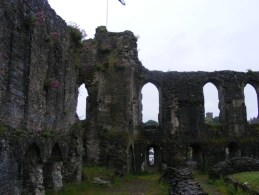 The rain was still falling when we awoke the next morning but was beginning to ease as we ate our breakfast. By the time we left at 9am it was only a drizzle and the sky looked much brighter. First port of call was the castle at Haverfordwest. This castle was first established by Gilbert de Clare, Earl of Pembroke in the mid 12th century, although his construction was probably of earth and timber so little now survives. The town of Haverfordwest was burnt to the castle gates by Llywelyn ap Iorwerth in the early 13th century.
The rain was still falling when we awoke the next morning but was beginning to ease as we ate our breakfast. By the time we left at 9am it was only a drizzle and the sky looked much brighter. First port of call was the castle at Haverfordwest. This castle was first established by Gilbert de Clare, Earl of Pembroke in the mid 12th century, although his construction was probably of earth and timber so little now survives. The town of Haverfordwest was burnt to the castle gates by Llywelyn ap Iorwerth in the early 13th century.
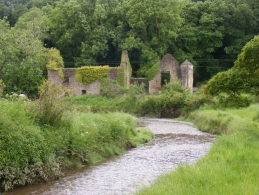
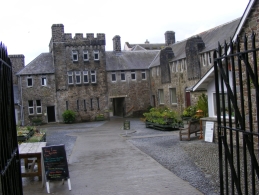 From here we cycled to Picton (shown on the right) - a castle built at the end of the 13th century - and then onto Cresswell (shown far right), which looks like a ruined farmhouse apart from the tower at the end (again built in the 13th century).
From here we cycled to Picton (shown on the right) - a castle built at the end of the 13th century - and then onto Cresswell (shown far right), which looks like a ruined farmhouse apart from the tower at the end (again built in the 13th century).
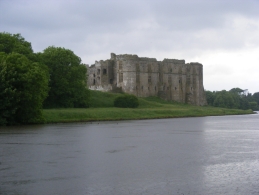 Next stop was a couple of miles south at Carew Castle - a marvellous construction overlooking a broad millpond which is normally filled at high tide (if the tide is high enough). The mill was a much later construction than the castle which was originally built by Gerald de Windsor in the early 12th century. Gerald was made castellan of Pembroke Castle and he married Nest of Wales the daughter of Rhys ap Tewdwr King of Deheubarth. His castle here was mainly of a timber construction however the keep was built in stone and still exists today. Most of what can be seen today was built by Nicholas de Carew (a descendant of Gerald) around 1270.
Next stop was a couple of miles south at Carew Castle - a marvellous construction overlooking a broad millpond which is normally filled at high tide (if the tide is high enough). The mill was a much later construction than the castle which was originally built by Gerald de Windsor in the early 12th century. Gerald was made castellan of Pembroke Castle and he married Nest of Wales the daughter of Rhys ap Tewdwr King of Deheubarth. His castle here was mainly of a timber construction however the keep was built in stone and still exists today. Most of what can be seen today was built by Nicholas de Carew (a descendant of Gerald) around 1270.
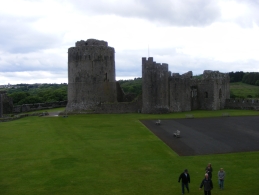 Onto Pembroke and a well earned first tea stop for the day - it was lunchtime already. This castle has to rank as one of the best to visit in the south west with plenty of towers to climb, rooms to view and walls to walk. In 1138 Gilbert de Clare became the owner of the castle - he was the first Earl of Pembroke. His son Richard "Strongbow" took over in 1148 and the inheritance passed to Richard's infant daughter Isabel de Clare when Richard died in 1176. The estate passed to the King (Henry II). In 1189 Isabel married William Marshal and he was invested as the 3rd Earl of Pembroke on 27th May 1199 by King John. At the centre of the castle is the Great Keep - this is thought to be the work of William Marshal but could have been one of the earlier de Clares. One can only marvel at how they managed to build such a high structure with it's domed stone roof. The walls are over 19ft wide at the base. We climbed to the top and out onto the ramparts for a magnificent view of the castle and town below.
Onto Pembroke and a well earned first tea stop for the day - it was lunchtime already. This castle has to rank as one of the best to visit in the south west with plenty of towers to climb, rooms to view and walls to walk. In 1138 Gilbert de Clare became the owner of the castle - he was the first Earl of Pembroke. His son Richard "Strongbow" took over in 1148 and the inheritance passed to Richard's infant daughter Isabel de Clare when Richard died in 1176. The estate passed to the King (Henry II). In 1189 Isabel married William Marshal and he was invested as the 3rd Earl of Pembroke on 27th May 1199 by King John. At the centre of the castle is the Great Keep - this is thought to be the work of William Marshal but could have been one of the earlier de Clares. One can only marvel at how they managed to build such a high structure with it's domed stone roof. The walls are over 19ft wide at the base. We climbed to the top and out onto the ramparts for a magnificent view of the castle and town below.
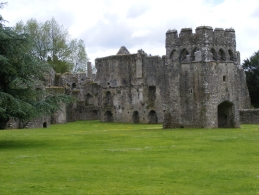 We ate our lunch inside the castle grounds before moving off again to Lamphey Bishops Palace - the ruins of a lavish country retreat used by the Bishops of St Davids. The lady on duty kindly let us in for five minutes to take photos of the ruins commenting that she was glad of someone to talk to!
We ate our lunch inside the castle grounds before moving off again to Lamphey Bishops Palace - the ruins of a lavish country retreat used by the Bishops of St Davids. The lady on duty kindly let us in for five minutes to take photos of the ruins commenting that she was glad of someone to talk to!
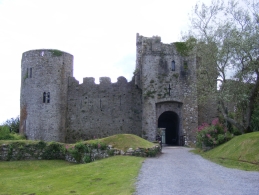 Next stop Manorbier, built originally by Odo de Barri and most probably of wood. His son William de Barri married Angharad the daughter of Gerald de Windsor and Nest and it was William who was responsible for the building as we see it today.
Next stop Manorbier, built originally by Odo de Barri and most probably of wood. His son William de Barri married Angharad the daughter of Gerald de Windsor and Nest and it was William who was responsible for the building as we see it today.
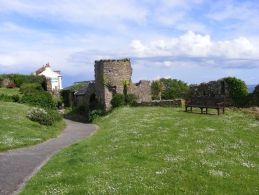 The final castle for the day was Tenby - not much left of the castle overlooking the North Beach at Tenby - and then we continued to Saundersfoot to our B&B and a well deserved rest.
The final castle for the day was Tenby - not much left of the castle overlooking the North Beach at Tenby - and then we continued to Saundersfoot to our B&B and a well deserved rest.
The mileage at the end of the day was 45 miles.
Castles visited - 7 plus Lamphey Bisphops Palace